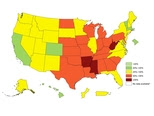오늘자로 미국의 CDC가 2014년도 비만에 관한 자료를 공개했다.
http://www.cdc.gov/obesity/data/adult.html
흥미로운 점 몇가지만...
1. 흑인과 히스패닉 남자들은 소득이 높을 수록 더 비만했다. 이는 소득이 높을 수록 날씬하다라는 것에 반하는 결과인데... 왜 그럴까? 인종과 젠더, 혹은 인종과 사회경제적 요소가 결합한 어떤 효과(?)가 있기 때문일까?
2. 전반적으로 교육과 비만과의 상관관계는 나타나지 않았지만, 대학졸업 이상의 여성들은 그 이하의 교육수준의 여성보다 덜 비만 한 것으로 나왔다고 한다. 아직 여성의 교육수준이 남성에 육박하지 못해서 일까? 아니면 여성의 비만은 교육과 상관관계가 있기 때문일까?
3. 미국 전국적으로 비만율은 흑인이 47.8프로, 히스패닉이 42.5프로, 백인이 32.6프로인데 비해 아시안은 10.8프로이다. 아시안에게 특별한 생활과 음식 습관이 있는 것일까? 아시안만의 다른 비만과 관련된 유전자가 있는 것일까?
4. 비만의 기준을 조금 더 높여야 할지 않을까? 현재 BMi기준으로 18.5-25까지를 정상이라고 하는데..... 너무 낮다는 생각이 든다.
5. 비만율은 몇년동안 조금 더 증가하겠지만 결국 정체하다가 감소할 것으로 본다. 이에대한 연구를 해보려고 한다. 어떻게 논거와 증거들을 끌어올 것인가? 나의 숙제다.
 | |||
September 21, 2015Now Available! CDC’S 2014 State Maps Detailing the Prevalence of Adults with Obesity Today, the CDC Division of Nutrition, Physical Activity, and Obesity released its 2014 state- and territory-specific data on the percentage of adults with obesity using self-reported information from the Behavioral Risk Factor Surveillance System (BRFSS). New adult obesity prevalence maps are available online at www.cdc.gov/obesity/data/
In addition, for the second year, maps of adult obesity by race/ethnicity have been released by CDC in which 2012-2014 data is combined. These maps highlight disparities in the epidemic. Combining data from 2012 to 2014:
BRFSS is the nation's state-based data tracking system that collects self-reported information (through telephone surveys) from U.S. residents about their health-related behaviors, chronic health conditions, and use of preventive services. BRFSS collects data in all 50 states, as well as the District of Columbia and select U.S. territories. BRFSS is only one of several data sets that allows obesity in the United States to be monitored. Data from the BRFSS, as well as from other data sets, including the National Health and Nutrition Examination Survey (NHANES) in which weight and height are measured, indicate that obesity continues to be a major public health problem. There are several ways organizations can create a supportive environment to promote healthy living behaviors that prevent obesity: http://www.cdc.gov/obesity/ | |||
'비만' 카테고리의 다른 글
| 노인 비만에서 간과하는 점 (0) | 2015.10.28 |
|---|---|
| 살은 뺄수 있다...... 단기간으로만 (0) | 2015.09.11 |
| BMI가 부정확한 비만측정방법이라면 대안은? (0) | 2015.08.29 |
| 비만인 사람이 몸무게를 줄여서 유지하는 건 거의 불가능하다 (0) | 2015.07.19 |
| (9) 당신의 타고난 몸무게는 몇 킬로그램 입니까? (0) | 2014.10.05 |




